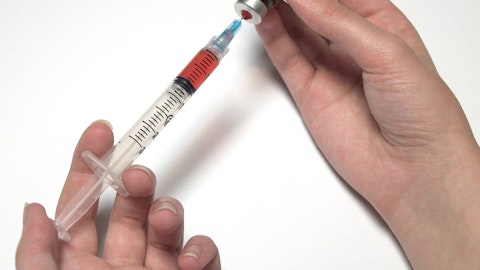And there we’re seeing really active uptake. We are up to four now drug approvals using our SmartDose platform. And we have a very active pipeline of customers that are evaluating the platform.
Eric Green : Excellent. Thank you Quintin.
Matt Larew: Okay. Excellent. And then next on capacity obviously sort of Kinston is ramping to full capacity. I think you referenced maybe adding to the Waterford site in 2024. So I guess just as we think about where capital is moving next from an investment perspective? Is it Waterford are there other sites or particular categories you have in mind? And as you’re doing that I know you’ve referenced building additional automation into newer builds are those things that can help speed time to ramp or more to benefit at steady state?
Eric Green : Yes. So the two points think about the first one in regards to the network and where we’re investing our capital particularly on HVP. It’s heavily concentrated between Kinston, a little bit in Jersey Shore up in Pennsylvania. But in Europe, it’s Waterford and Eschweiler. And we’re also looking at additional expansion in Singapore to build support the Asia market. But the priority has been really around the U.S. and Europe and we’ll continue to invest. And it’s interesting the growth that we’re experiencing with HVP to build support that. It is really around when you think about the pharma washing sterilization and vision that is helping us to drive the HVP conversion. So I’m excited about where we are, but also the investments that are in flight.
What that will give us and also give us the ability to do uplift and the additional demand that we expect. The automation is ongoing. And actually I’m pleased with some of the recent progress we made on new technology for West that allows us to be more efficient improve quality. In my mind I’m always looking at ways to improve safety. It also allows us to scale up faster when we start thinking about to support various areas whether it’s biologics I mentioned earlier, about oncology, immunology or auto-immune but it’s also thinking about how do we support the scale-up on GLP-1. And so this automation that we’re working on with a couple of our external partners, I need to get over to Europe recently to see some new investments that we put in place.
I’m excited for what the engineering team has been doing, and it’s going to give us the ability to scale faster. But more importantly, I think the automation will provide a better product that continues to differentiate West in the marketplace. That’s what I’m really excited about. Yes, we’ll get efficiencies. Yes, we’ll get more throughput. But reality is — main focus is a higher-quality product that differentiates the market.
Matt Larew: Okay. Thank you.
A – Eric Green: Thank you.
Operator: Thank you. One moment as we move to our next question. And our next question is going to come from the line of David Windley with Jefferies. Your line is open. Please go ahead.
David Windley: Hi, good morning. Thanks for taking my questions. Best to Bern and his family. I wanted to start on stocking and just to understand some moving parts a little bit better. I’m understanding, I think well that you’re talking today that within elastomers or components the destocking is mostly standard. I think early in the year, we had understood that you had some areas that post pandemic maybe Westar for example, post pandemic had not gotten the capital allocation the growth allocation and were understocked and catching up. And so I guess, I wanted to try to understand better if those two factors were both at play and offsetting in the quarter or maybe the Westar was already done and therefore, the standard destocking now is what we’re feeling. It feels like there have been through the year, moving parts in both directions and I just wanted to understand those and the cadence of them. Thanks.
A – Eric Green: It’s a good question
Quintin Lai: Thanks, Dave. So maybe it’s just a definition or just maybe when you say destocking, we think of it more as customers that are having a demand issue like in COVID-19 and what they’re doing is they’re not reordering. And they’re taking down their safety stock, and consuming their safety stock. And that’s certainly happening in COVID-19, which we’re seeing year-over-year declines. The other impact is the fact that we have been behind in terms of delivering, because of our capacity constraints. And then, as we’ve been able to restock, the base growth that you’ve seen in generics and pharma is well above the financial construct. So, that has been going on for the first part of this year. What we’re seeing now is that that base growth is going to temper, it’s not declining.
It’s just not going to be as high as we thought it was going to be in Q4. That’s why we’re calling it, a slowing of a restock. It’s not necessarily a destock situation. And again, a lot of it happens is the fact that we’ve done a really good job of clearing the backlog. We’ve been — we’ve gone to our customers we said “Hey, we have that capacity to deliver product. And they said “No, given where we are in the year, given where our manufacturing schedules are, we would rather be delivered next year instead of Q4.
David Windley: Okay. Helpful. Thank you. In thinking about your initial comments on 2024. And admittedly, the — I appreciate your answer to Paul’s question to start on GLP-1s. And I think we all know that the attention there is probably overwrought. But in so much as there’s a lot of enthusiasm for that particular class, I think your folks that are paying attention to West believe that that can be a very strong driver for you perhaps in excess of your long-term construct. Would you tell us that that is — that our assessment of that is too enthusiastic? Or is it that the pace at which that comes on is perhaps, not as quick as we think? Or is it that other parts of the business are offsetting and those things net you into that 7% to 9% target range? Thanks.
Quintin Lai: So, again, I understand your question, here’s our philosophy. We need to be ready for whatever the customers need from us. And so we have — that’s why our teams have such great communication with the customers. We have cited that we have customers that are doing really well, and are increasing their reorders. In the event that those things change to the positive, that’s where our global network is ready. We are — so we’re in position for that. We’ve got the global network to do that. And so now what happens to that class of drug that’s really better addressed by our customers. All we can say is that we’ll be ready and continuing to be ready and that’s why we got so much capital projects going on right now. Eric?




